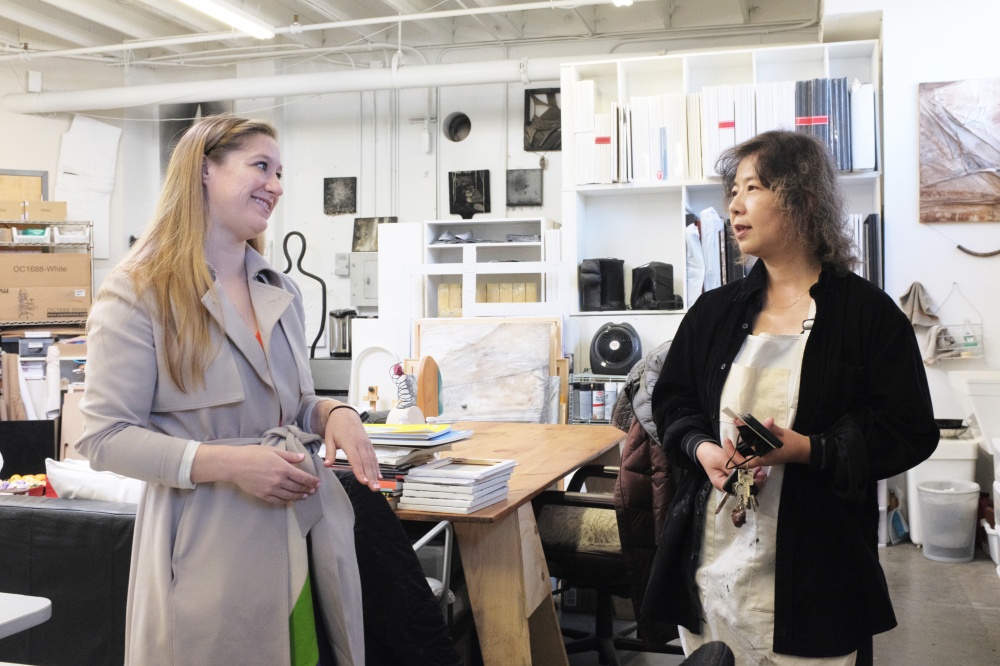Are you an artist trying to find alternative income streams or sell more art? Have you consider opening your studio to art buyers and collectors? This is how you do it. At our visits to artist's studios we noticed good practices that help artists sell more art. Follow these 10 simple tips to present your artworks in the best light.
1. Clean up your studio.
Let's be honest, some artist, when they create, are pretty messy. If this is you, prepare your studio for a formal visit! Your studio is an extension of your art practice. Think about what your space tells about you. Wipe the floors, dispose of the waste, clean the sink area. Use the walls to display your recently finished art. Use this opportunity to document, catalogue and store your artwork. Store old and unfinished artworks. Think about presence of 10 people in your space. Are they going to have enough room to move and experience your artwork? How likely they will knock down your new sculpture? Can your wet paint ruin their clothes? Ventilate your studio. Some people are very sensitive to fumes!
2. Advertise early.
Start promoting your event one month ahead. If you are part of an artist collective or you share a studio space, reach out to the space manager. If you inform them early enough they can share your event in their newsletter or on social media. Be creative with finding alternative promotional channels. Submit your event to local facebook groups or online event calendars. For San Francisco Bay Area list your studio event in SF Arts, Do The Bay, Marina Arts, SF Fun Cheap, Oakland Magazine, East Bay Mag, Oakland Central, Diablo Magazine, Eventbrite and Meetup.
3. Invite the right people.
You don't want time wasters in your studio. Frame the situation from beginning. When you're inviting people to your studio talk about the purpose of the visit. Visitors are in your studio to inspect and consider buying your art! Invite art buyers and art collectors that you know. If you don't know any ask your artist friends. Friends and family members can come other time. On social media experiment with hashtags #artforsale, #artmarket, #artbuyer, #artdealer or #artcollector.
4. Mark your studio well.
Some studio buildings can be difficult to navigate. Welcome your visitors at the main gate. An extra person can be handy to help your late visitors get inside. Create two temporary signs informing about your event. One for your studio door and one for building's main entrance. It looks professional and reassures the visitors that they are at the right place. The will be also able to leave and come back without your help.
5. Have an agenda.
Be prepared, control the situation! Plan for 1 hour. Think about the first minute when visitors enter your studio. Think about how to end of the studio visit. Think about the time between. Welcome visitors, present them with your agenda. Start with introducing everyone who come to your studio. Ask how they learned about the event and what they expect from the visit. Continue with your artist introduction. Talk about how you have started, where you are now and what do you plan to do next. Selected 1-3 artworks to talk about. Explain your intention, your inspiration and technique that you use. Make space for visitor's questions, but remind them of your time constraints. End on a high note! Share your business contacts with interested guests. Process orders and say goodbye!
6. Offer refreshments.
You don't have to serve the alcohol but few water bottles will help refresh both you and your visitors. This is time when artist needs to speak up and show their artworks in best light. Refreshments makes atmosphere more hospitable and shows an extra effort that you made. Some artists go an extra step and provide food. This is not necessary. Studio visit shouldn't be too long to starve you!
7. Talk about price early.
Ballpark your artwork's price early on. Explain the price difference when visitor buys artwork in studio from you or from a gallery. The worst situation is when visitors run out of questions but no one has asked about the price! It intimidating to transition from a friendly artist to a pushy salesman! If don't know how to open money discussion try to memorize something like this:
Hey! Welcome! I'm Miriam, the artist. Feel free to look around. My latest works are on the wall. My older works are back there. If you like something let me know, we can discus price. The original paintings are from 5 to 50 thousand dollars, for the biggest pieces like this. I understand that that my price range might not be for everyone here. That's why I made these limited prints for 200 dollars each. And this little swag here! :)
8. Have price list ready.
If you don't like to talk about prices prepare price list of your artworks. With nice pictures of your artwork list year, size, used materials and price. Organize your artwork by art technique or by year created. Print 3 copies and place it to your studio. If you don't know how to price your artwork, ask more experienced artist in your community. If you are in doubt start with a higher price and leave a space for negotiation.
9. Do not expect sales on spot.
Some people might not be comfortable open wallet or even talk about prices in front of the others. Collectors often need more time to think when buying artwork. They like to consider new art in the space where they plan to display it. If someone want to buy artwork on the spot, be prepare to process credit card. Venmo, Paypal or Square reader can save you from an embarrassing moment or a missed sale.
10. Prepare small gift.
Not every visitor ends up being your collector, but every visitor can be your advocate. Your visitors have already made an extra effort to come to your studio. Appreciate them with a small gift, that looks cool in pictures. It will be a great prompt to share your name on social media. You don't have to dilute your art by creating new cheap artworks to give away. A nice post card that you already have or a signed page from your old sketchbook can make an excellent present.

